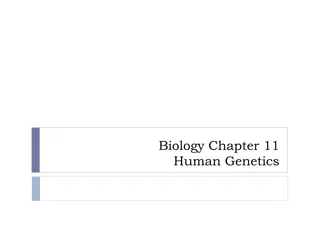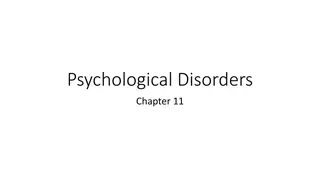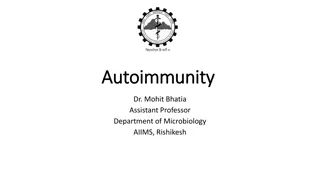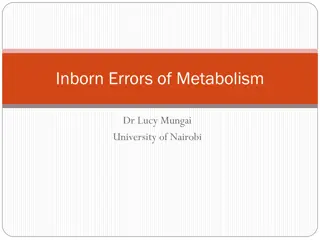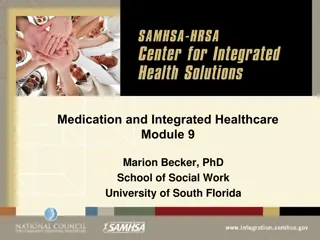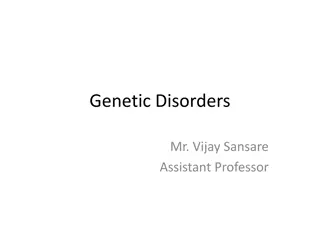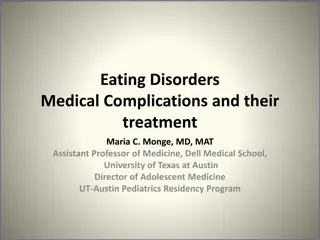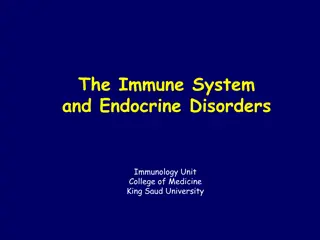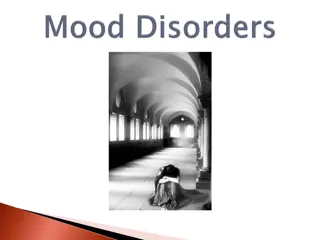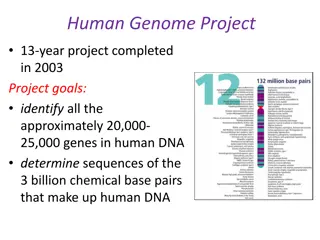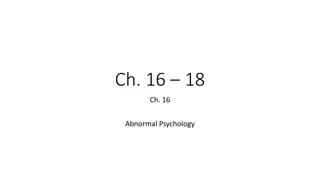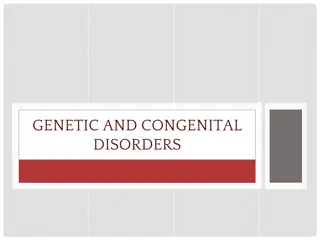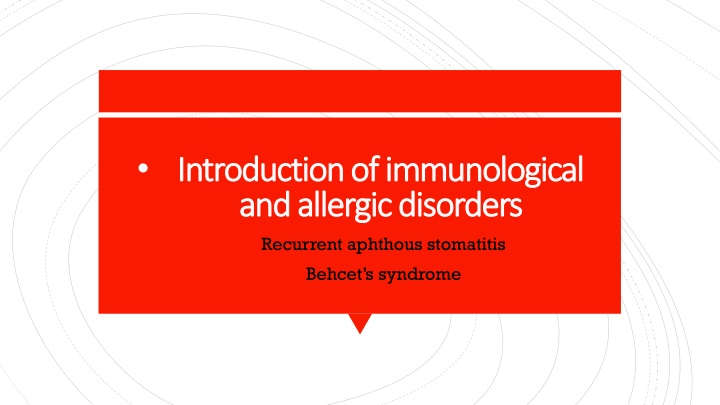
Immunological and Allergic Disorders: A Comprehensive Overview
Explore the world of immunological and allergic disorders, including recurrent aphthous stomatitis and Behcet's syndrome. Learn about hypersensitivity reactions, autoimmune diseases, and immunodeficiency. Delve into the types of allergic reactions and the broad term of allergy, encompassing hypersensitive states and altered reactions. Discover the different categories of allergic reactions and the common condition of recurrent aphthous stomatitis characterized by small ulcers.
Download Presentation

Please find below an Image/Link to download the presentation.
The content on the website is provided AS IS for your information and personal use only. It may not be sold, licensed, or shared on other websites without obtaining consent from the author. If you encounter any issues during the download, it is possible that the publisher has removed the file from their server.
You are allowed to download the files provided on this website for personal or commercial use, subject to the condition that they are used lawfully. All files are the property of their respective owners.
The content on the website is provided AS IS for your information and personal use only. It may not be sold, licensed, or shared on other websites without obtaining consent from the author.
E N D
Presentation Transcript
Introduction of immunological Introduction of immunological and allergic disorders and allergic disorders 1. Recurrent aphthous stomatitis 2. Behcet s syndrome
Immunological disorders are diseases or conditions caused by a dysfunction of the immune system and include allergy, asthma, autoimmune diseases, autoinflammatory syndromes and immunological deficiency syndromes Immunological disorders
Immunological Disorders Introduction A. There are three types of immunological disorders 1. Hypersensitivity Immunological disorders 2. Autoimmune disease 3. Immunodeficiency B. Hypersensitivity reactions to usually harmless substances are often called allergies or allergic reactions
Immunological Disorders 1. allergens - antigens that cause allergic reactions C. Most allergic reactions fall into one of four major types: Immunological disorders 1. Type I: Immediate IgE-mediated 2. Type lI: Cytotoxic 3. Type III: Immune complex-mediated 4. Type IV: Delayed cell-mediated
Allergy is a broad term used generally to encompass the hypersensitive state acquired by exposure to a specific material ,and the altered capacity of the living organisms to react upon re- exposure to it . Allergy
There are two general types of allergic reactions ; One type of reaction is the so called IMMEDIATE REACTION . It is associated with antibodies circulating in the ser of the allergic person and includes anaphylaxis,hay fever and asthma ,serum sickness ,angioedema . Allergy The second category of reaction or DELAYED REACTION, It is generally not associated with circulating antibodies since the causative agents are not strictly antigens they attain antigenic properties by combining with tissues of the individual
RECURRENT APHTHOUS STOMATITIS (RAS/ aphthae/canker sores) Recurrent aphthous stomatitis It is a common condition which is characterized by multiple recurrent small, round or ovoid ulcers with circumscribed margin, erythematous halos and yellow or grey floors, appearing first in childhood or adolescence.
Clinical features RAS may affect 5-60yrs. Recurrent aphthous stomatitis Female predominance. Seen more predominantly in children. RAS consist of recurrent bouts of one or several rounded, shallow, painful oral ulcers at intervals of a few days to few months.
Recurrent aphthous stomatitis RAS shows 3 main presentations- Minor (MiRAS), Major (MaRAS), Herpetiform ulcers (HU)
Minor recurrent aphthous stomatitis (MiRAS) Most common affecting about 80% of RAS patients, Minor Recurrent aphthous stomatitis Characterized by: Round or oval shallow ulcers, 1-5 in no. Common sites: Nonkeratinized mucosa, labial and buccal mucosa and floor of the mouth
Shortest duration, Heal within 10-14 days without scarring. Size: < 5 mm, with a grey-white pseudomembrane enveloped by a thin erythematous halo. Minor recurrent aphthous stomatitis Burning, itching, or stinging, development of erythematous macule Most common form of childhood RAS
Major recurrent aphthous stomatitis (MaRAS) Rare, severe form of RAS, also known as periadenitis mucosa necrotica recurrens. Major recurrent aphthous stomatitis Lesions are oval. Size: 1 cm -3cm Sites: lips, soft palate, and fauces 1-10 in no.
Persist for up to 6 weeks. Heal with scarring. Major recurrent aphthous stomatitis Onset: after puberty and is chronic, persisting for up to 20 or more years. Most frequent recurrences Coalesce into larger irregular ulcerations
Herpetiform ulcers (HU) Least common variety of RAS. Characterized by: Herpitiform ulcers Multiple recurrent crops of small, painful ulcers. Sites: May be distributed throughout the oral cavity. No.: 100 Size: 2-3 mm in diameter. Late onset
Etiology Genetic - (Human Leukocyte Antigen) (present on cell membrane) Recurrent aphthous stomatitis HLA- DR2, HLA-B12 Local factors: - Trauma (self inflicted bites ,oral surgical procedure etc..) Systemic factors: - Drugs such as NSAIDS - Stress
- Hematinic (iron, folic acid, or vitamin B12) deficiencies - Zinc deficiency -Bechet s syndrome Recurrent aphthous stomatitis - Celiac disease - Cyclic neutropenia - Some immunodeficiencies, HIV - MAGIC syndrome (mouth and genital ulcers with inflamed cartilage) - PAPA syndrome (periodic fever, aphthous stomatitis, pharyngitis, cervical adenitis)
Microbial Aspects of RAS (Streptococcus ) Recently, cross-reactivity between a streptococcal heat shock protein (hsp) and the oral mucosa has been demonstrated and significantly elevated levels of serum antibodies to hsp are also observed in RAS. (Lehner et al., 1991). Microbial aspect of RAS Association of RAS with adenoviruses & herpesviruses 1-6 is also seen. IgM and IgG antibodies to varicella zoster virus (VZV) and cytomegalovirus (CMV) may be elevated in some RAS patients, suggesting association between them and RAS.
microscopic changes in RAS:- Pre ulcerative stage: lymphocytes infiltrate the epithelium and edema develops. Microscopic changes in RAS Ulcerative stage: Increase of pain. *Development of localized papular swelling (because of keratinocyte vacuolization) surrounded by a reactive erythematous halo representing localized vasculitis with a dense mononuclear cell infiltrate
Histopathologic Features Central zone of ulceration covered by fibrinopurulent membrane Increased vascularity, mixed inflammatory cellular infiltrate Histopathologic al features Numerous mononuclear cells in basilar one third Band of lymphocytes intermixed with histiocytes in superficial connective tissue and surrounding deeper blood vessels
Behcets Disease (BD) Also called Beh et s syndrome, Morbus Beh et, or Silk Road disease, is a rare immune-mediated systemic vasculitis. Beh et s disease (BD) was named in 1937 after the Turkish dermatologist Hulusi Beh et, who first described the triple-symptom complex of Behcet s Behcet sDisease Disease -recurrent oral aphthous ulcers, genital ulcers, and -uveitis (eye ) Behcet s Disease (BD)
Behcets Disease
Behets syndrome is a multisystem disorder presenting with- Recurrent oral and Behcet s syndrome genital ulcerations and Ocular involvement Diagnosis is clinical, based on internationally agreed diagnostic criteria
Clinical Features Males and females affected equally Males often have more severe diseas Blacks are rarely affected Diagnostic Criteria of Beh et s Disease Clinical features Recurrent oral ulceration plus two of the following:- Recurrent genital ulceration -Eye lesions Skin lesions -Pathergy test (lesion resistent to healing )
Orogenital ulceration Recurrent aphthous ulcers Painful, shallow /deep with central necrotic base Singly or in crops Variable size Located anywhere in the oral cavity Clinical features Persist X 1-2 weeks, subside without scars The genital ulcers less common, but more specific Painful glans penis and urethra, and produce scrotal scars
2. Skin involvement -80% Folliculitis Erythema nodosum An acne-like exanthem Vasculitis (infrequent) Clinical features Sweet's syndrome Pyoderma gangrenosum Nonspecific skin inflammatory reactivity to any scratches or intradermal saline injection (pathergy test) is a common and specific manifestation.
3. Eye involvement in 50% Scarring and bilateral pan-uveitis Iritis, posterior uveitis, Clinical features Retinal vessel occlusions, and Optic neuritis
4. Joints- 50% Non-deforming arthritis or arthralgias Clinical features Knees and ankles
Vascular Venous: 50% Superficial/ deep peripheral vein thrombosis in 30% Clinical features Pulmonary emboli rare peripheral arterial aneurysm Arterial thrombosis
6. Neurologic involvement (5-10%) Brainstem involvement of serious prognosis (CNS- Beh et's syndrome). Clinical features Dural sinus thrombi (20%) (headache and increased ICP).
6. Others Gastrointestinal more in Japanese, resembles Crohn s Clinical features Epididymitis Amyloidosis & glomerulonephritis uncommon.
There is no specific treatment for behcets disease other than symptomatic or supportive measure TREATMENT Mucous membrane involvement : topical glucocorticoids TREATMENT Serious cases- thalidomide Mucocutaneous manifestations and arthritis: Colchicine Thrombophlebitis Aspirin
Uveitis and CNS-Behets Systemic steroids Azathioprine Cyclosporin Pulmonary or peripheral arterial aneurysms Cyclophosphamide


